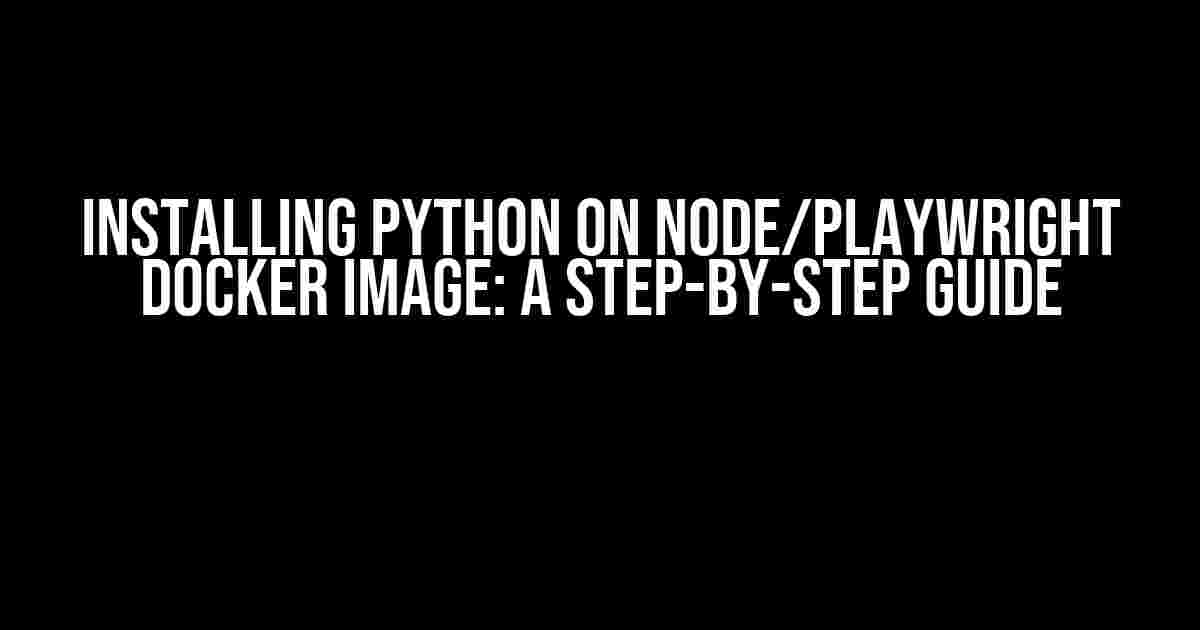Are you tired of struggling to install Python on your Node/Playwright Docker image? Do you find yourself stuck in a never-ending loop of error messages and frustration? Fear not, dear reader, for we’re about to embark on a journey to resolve this conundrum once and for all!
Why Do I Need Python on My Node/Playwright Docker Image?
Before we dive into the installation process, let’s quickly discuss why you might need Python on your Node/Playwright Docker image. Python is a popular language used for various tasks, such as data analysis, automation, and scripting. Having Python installed on your Docker image can greatly expand its capabilities and make it more versatile.
In the context of Playwright, Python can be used for tasks like:
- Web scraping and data extraction
- Automating browser interactions
- Running Python scripts alongside your Node.js application
Prerequisites
Before we begin, make sure you have the following:
- Docker installed on your machine
- A basic understanding of Docker and Node.js
- A Node/Playwright Docker image (e.g.,
mcr.microsoft.com/playwright:bionic-full)
Method 1: Installing Python Using a Dockerfile
One way to install Python on your Node/Playwright Docker image is by creating a custom Dockerfile. This approach allows you to tailor the installation process to your specific needs.
Create a new file called Dockerfile with the following contents:
FROM mcr.microsoft.com/playwright:bionic-full # Install Python and dependencies RUN apt-get update && apt-get install -y python3 python3-pip # Verify Python installation RUN python3 --version
Let’s break down the commands:
FROM mcr.microsoft.com/playwright:bionic-full: We start by using the official Playwright Docker image as our base.RUN apt-get update && apt-get install -y python3 python3-pip: We update the package list and install Python 3 along with pip (the package installer) using apt-get.RUN python3 --version: We verify the Python installation by checking its version.
Next, build the Docker image by running the following command:
docker build -t my-playwright-python-image .
This will create a new Docker image with Python installed.
Method 2: Installing Python Using a Docker Compose File
Another approach is to use a Docker Compose file to install Python on your Node/Playwright Docker image. This method is useful when you want to manage multiple services or dependencies.
Create a new file called docker-compose.yml with the following contents:
version: '3'
services:
playwright:
image: mcr.microsoft.com/playwright:bionic-full
command: ["/bin/bash", "-c", "apt-get update && apt-get install -y python3 python3-pip && python3 --version"]
Let’s break down the configuration:
version: '3': We specify the Docker Compose version.services:: We define a service namedplaywright.image: mcr.microsoft.com/playwright:bionic-full: We use the official Playwright Docker image as our base.command: ["/bin/bash", "-c", "apt-get update && apt-get install -y python3 python3-pip && python3 --version"]: We run a command that updates the package list, installs Python 3 and pip, and verifies the installation.
Run the following command to start the Docker container:
docker-compose up -d
This will create a new Docker container with Python installed.
Verifying Python Installation
Now that we’ve installed Python using one of the above methods, let’s verify that it’s working correctly.
Run the following command to access the Docker container:
docker exec -it my-playwright-python-image /bin/bash
Once inside the container, type:
python3 --version
If everything went smoothly, you should see the Python version printed in the terminal.
Common Issues and Troubleshooting
While installing Python on your Node/Playwright Docker image, you may encounter some common issues. Here are a few troubleshooting tips:
| Issue | Solution |
|---|---|
| Python installation fails | Check the Dockerfile or docker-compose.yml for syntax errors. Make sure you have the correct base image and dependencies installed. |
| Python version is incorrect | Verify that you’re installing the correct version of Python (e.g., Python 3.x). Check the package manager logs for any errors. |
| Python packages are not installable | Ensure that pip is installed and up-to-date. Try reinstalling the package manager or upgrading pip. |
Conclusion
Installing Python on your Node/Playwright Docker image is a straightforward process that can be accomplished using a Dockerfile or a Docker Compose file. By following the steps outlined in this article, you should now have a working Python environment within your Docker container.
Remember to verify the Python installation and troubleshoot any common issues that may arise. Happy coding!
Keywords: Installing Python on Node/Playwright Docker image, Dockerfile, Docker Compose, Python installation, Node.js, Playwright, Docker container.
Here are the 5 Questions and Answers about “Installing Python on Node/Playwright docker image”:
Frequently Asked Question
Having trouble getting Python to work on your Node/Playwright Docker image? We’ve got you covered! Check out our top 5 FAQs to get you up and running in no time!
Q1: Why do I need to install Python on my Node/Playwright Docker image?
You need to install Python on your Node/Playwright Docker image because some browsers, like Chrome, require Python to function properly. Plus, having Python on board opens up a world of possibilities for automating tasks and running scripts!
Q2: What’s the best way to install Python on my Node/Playwright Docker image?
The easiest way to install Python is to add a RUN command in your Dockerfile. For example, you can use `RUN apt-get update && apt-get install -y python3` to install Python 3. This ensures that Python is installed and ready to go in your container!
Q3: Do I need to install any additional dependencies for Python to work with Playwright?
Yes, you’ll need to install a few additional dependencies, like `libgconf-2-4` and `libasound2`, to ensure that Playwright works smoothly with Python. You can add these dependencies to your Dockerfile using the `RUN` command, just like you did for Python!
Q4: Can I use a Python version manager like Pyenv or Conda in my Docker image?
While it’s technically possible to use a Python version manager like Pyenv or Conda in your Docker image, it’s not recommended. These managers can add extra complexity and may not play nicely with the Docker environment. Stick with the Python version that comes with your base image or install a specific version using `apt-get` for simplicity!
Q5: How do I verify that Python is installed correctly on my Node/Playwright Docker image?
To verify that Python is installed correctly, simply run the `python3 –version` command in your container. If everything is set up correctly, you should see the version of Python that you installed. You can also try running a simple Python script to ensure that it’s executing properly!




